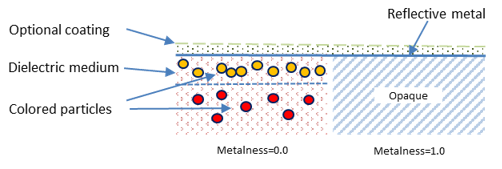The Physical Material uses a shading model including most reasonable shading effects for real world materials, while maintaining a balance of being easy to use with a logical layout.
Note: The material appears in the Material/Map Browser only if the active renderer supports it.
The Physical Material is a modern, layered material with controls focused on physically-based workflows. It is compatible with the ART renderer.
Note: While the Physical Material will render using the legacy Scanline renderer, Scanline is not suitable for physically based rendering. It only renders a representation of the material and lacks many of the more intricate shading effects.
The material includes:
- a base layer that is either a diffuse color with a Fresnel-driven dielectric relection, or colored metallic reflections
- transparency
- sub-surface scattering/translucency
- emission (self-illumination)
- a clear-coat layer on top.

Energy Conservation
The Physical Material conserves energy as it ensures light does not amplify. The sum of the various shading components can never be more than 100%, ensuring the light energy is only scattered or absorbed, not created. The exception to this is emission, which adds energy.
Note: The math for the energy conservation works strictly on the weight parameters and the color parameters are ignored. Also, sub-surface scattering shares its energy with the diffuse reflectivity. For example, if the sub-surface scattering has a weight of 0.5, it will take away 50% of the energy from the diffuse even if the sub-surface scattering color is set to black, yielding no effective scattering at all.
Think of the energy conservation logic as layering of shading effects.
- Sub-surface Scattering takes energy from Diffuse. If the Sub-surface Scattering weight is 1.0, there is no Diffuse.
- Transparency takes the weight from Diffuse and Sub-surface Scattering. If the Transparency weight is 1.0, there is no Diffuse or Sub-surface Scattering.
- Reflections take the weight of all other layers.
- When Metalness is 0.0, Reflection weight takes the angular dependency (Fresnel effect based on the Index of Refraction or the custom curve) into account. Even if the Reflection weight is 1.0, the actual reflectivity is lower due to the Fresnel curve; energy is taken from Transparency/Diffuse/Sub-surface Scattering only relative to the amount defined by the curve.
- When Metalness is 1.0, the Physical Material is considered opaque. It does not have any Diffuse/Transparency/Sub-surface Scattering effects.
- The clear coat layer lies on top of all other layers, reducing energy based on how much it reflects and the transparency color of the coating.
- The emission layer is strictly additive and adds light energy regardless. It does not participate in energy conservation.
Interface
